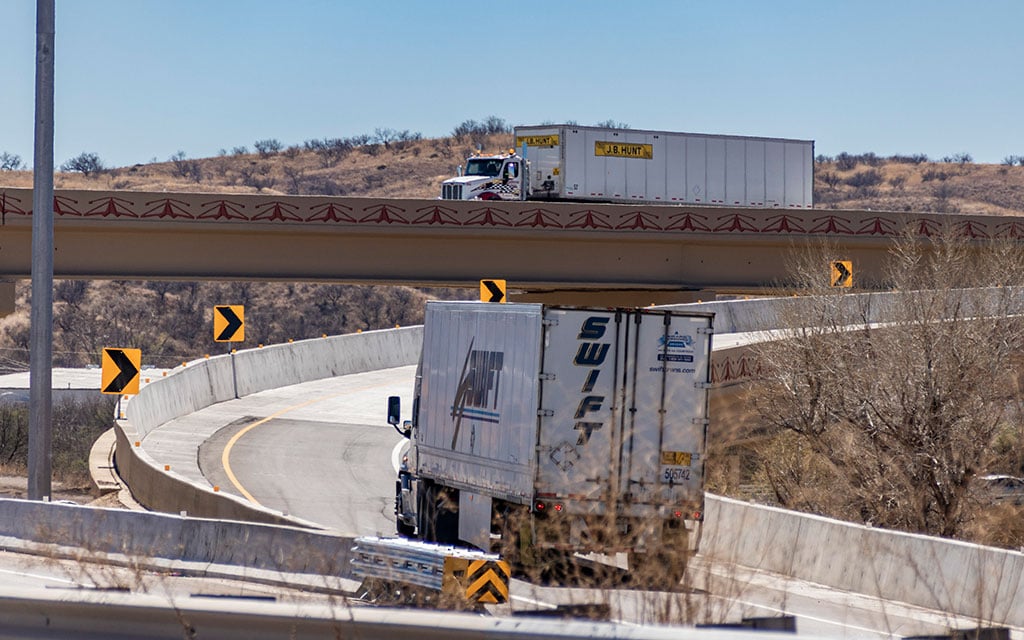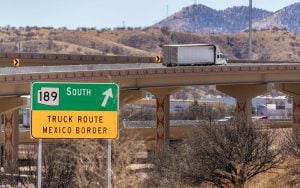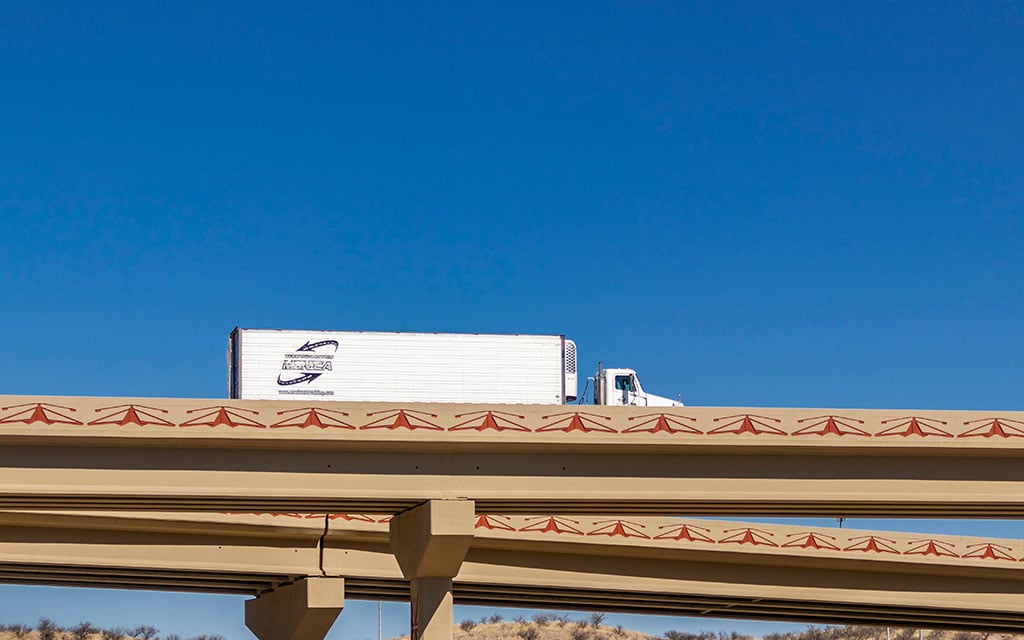
Trucks drive on SR-189 in southwest Arizona on March 10, 2022. (Photo courtesy of Arizona Department of Transportation)
WASHINGTON – Law enforcement from Arizona and other states descended on Congress on Wednesday, lobbying against a proposal to allow much heavier trucks on the nation’s highways.
Backers say the idea would improve the supply chain. But Jeffrey Hawkins, president of the Arizona State Troopers Association, warned that heavier semitrailers would endanger other drivers and lead to more serious crashes.
“We only have 63% of Phoenix filled, currently, with troopers,” he said outside the office of Rep. Andy Biggs, R-Ariz., following a meeting with him. “It doesn’t matter what part of the state it’s going to be. There’s less folks, so it takes us longer to get there, if we get there at all.”
All but two of Arizona’s 15 counties – Maricopa and Pima – have no troopers on the road from midnight to 4 a.m., he said. That means longer response times, making it even more important to avoid adding new risks.
In January, the House Committee on Transportation and Infrastructure approved a bill allowing trucks weighing up to 91,000 pounds on interstate highways during a five-year pilot program. Bigger trucks would require a sixth axle – attached to a trailer, standard 18-wheel semitrucks have five axles – which backers argue also means more braking capacity.
Congress set the current 80,000-pound limit in 1982 and has resisted efforts since then by the shipping industry to allow bigger and heavier trucks, which let a driver haul more cargo.

A truck drives along SR-189 on March 10, 2022. (Photo courtesy of Arizona Department of Transportation)
During the proposed pilot program, the Department of Transportation would track crashes and determine whether heavier trucks cause more injuries and fatalities – effectively turning other drivers into “guinea pigs,” according to the Coalition Against Bigger Trucks.
That group comprises law enforcement, independent truck drivers, engineers, elected officials and rail freight interests that compete with the trucking industry. Hawkins’ daylong visit to the Capitol to lobby Arizona lawmakers was organized by the group.
He and counterparts from Louisiana and Illinois highlighted concerns about highway safety, congestion and infrastructure damage from bigger trucks with lawmakers from their states. Members from California did the same a few months ago.
“They’re all doing the same thing, talking about the potential damage to infrastructure and the fact that our bridges currently can’t sustain a 91,000-pound load,” he said.
Hawkins met with Sen. Kyrsten Sinema, I-Ariz., and as many representatives as he could. The consensus was positive, he said, and lawmakers appreciated explanations about the difference 11,000 pounds can make.
Tractor-trailers were involved in 2,760 crashes in Arizona in 2022, according to the Arizona Department of Transportation. That includes crashes of tractors not pulling a trailer. In 2022 there were 111 fatal collisions, according to the Arizona Department of Transportation.
The Association of American Railroads and other opponents of the bigger trucks see an assortment of driving challenges, including longer stopping distances and more time needed for acceleration and braking.

A truck crosses a bridge on SR-189 on March 14, 2022. (Photo courtesy of Arizona Department of Transportation)
The Shippers Coalition has countered by saying the mandated extra axle would allow for better braking performance.
The group includes more than 80 prominent companies in manufacturing, food, beverage and agribusiness, among them Coca-Cola and Pepsico, Procter & Gamble, Anheuser-Busch, Koch Industries, Tyson Foods and The Home Depot.
The coalition argues that thanks to advancements in the last four decades, truck dimensions wouldn’t have to change. With more cargo per load, fewer trucks would be on the road, it says – though the counterargument is that lifting the weight cap would shift demand away from trains, creating an influx of trucks on the road.
A report from the National Association of Counties and the National Association of County Engineers in early 2023 identified roughly one in five bridges nationwide that couldn’t handle the heavier trucks. The report estimated the cost to local taxpayers at $60 billion for repair and upgrades.
Currently, trucks can be over the weight limit with a special permit. The Federal Highway Administration has said it doesn’t have enough data to compare crash rates between trucks above and below 80,000 pounds.
Supporters of raising the weight limits say that would improve the efficiency of the freight shipping industry and hold down costs for consumers.
Arizona temporarily increased the limits for trucks coming from Mexico to 83,000 pounds in 2016. It allowed containers coming through the Port of Tucson to be transferred to trucks without having to offload some of the contents.

